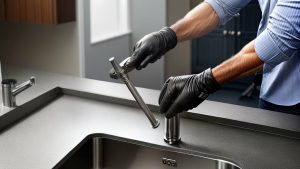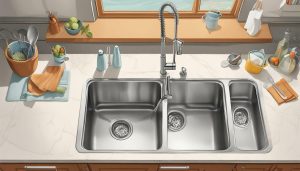Are you tired of the constant dripping of your kitchen faucet? Not only can a leaky faucet be annoying, but it can also lead to significant water wastage and potentially expensive water damage. Fortunately, fixing a leaky faucet is a relatively simple DIY task that you can accomplish with the right tools and some basic plumbing knowledge. In this expert guide, we will show you step-by-step how to fix a leaky kitchen faucet and save money on costly plumber’s fees.
Key Takeaways
- Fixing a leaky kitchen faucet is a simple DIY task that can save you money on costly plumber’s fees.
- The source of the leak must be correctly identified before beginning any repair work.
- Gathering the necessary tools and replacement parts beforehand will make the repair process much more manageable.
- Turning off the water supply is critical to ensure a safe and efficient repair.
- Disassembling and inspecting the internal components of the faucet is crucial to identify and repair any damage or wear.
- Reassembling the faucet carefully and testing for leaks is necessary to ensure optimal performance.
Identifying the Source of the Leak
If you have noticed that your kitchen sink faucet is leaking, it’s important to determine the source of the leak before attempting any repairs. This will ensure that you are addressing the specific issue and not wasting time fixing components that are not causing the problem.
Start by inspecting the faucet closely to identify where the water is coming from. If the water is dripping from the spout, the issue could be caused by a worn-out washer or cartridge. If the water is leaking from the base of the faucet, the problem may be related to loose connections or a faulty O-ring.
Another common location for leaks is around the handles of the faucet. If this is the case, the issue may be caused by a damaged stem or loose connections. It’s essential to identify the exact location of the leak before proceeding to the next step.
Gathering the Necessary Tools and Replacement Parts
Fixing a dripping faucet in the kitchen can be a relatively simple and cost-effective DIY task. Before starting the repair process, ensure you have the necessary tools and replacement parts on hand.
Here’s a list of essential items you’ll need:
| Tools | Replacement Parts |
|---|---|
| Adjustable wrench | Washers |
| Pliers | Cartridges |
| Flathead screwdriver | O-rings |
| Phillips head screwdriver | Plumber’s tape |
| Allen wrench set | – |
Most of these tools and parts can be easily found in a home improvement or hardware store. As for replacement parts, ensure that you purchase ones that are compatible with your faucet’s make and model.
With these tools and replacement parts on hand, you’ll be ready to tackle a leaky kitchen faucet and save money on a plumber’s visit.
Turning Off the Water Supply
Before beginning any repairs on your leaky kitchen faucet, it is essential to turn off the water supply to the faucet. This step will prevent any further water damage and ensure your repair process goes smoothly.
The location of the water shutoff valves may vary depending on the configuration of your plumbing system. For a single-handle faucet, turn off the valve located under the sink. For a double-handle faucet, turn off both the hot and cold water valves located under the sink.
It is important to ensure that the water is completely shut off before proceeding with the repair. Test the water flow by turning on the faucet after you have shut off the water valves. If no water flows, then the water supply is successfully turned off, and you can proceed with the repair process.
Disassembling the Faucet
If you’ve identified your kitchen faucet as the source of dripping water, the next step is to disassemble it to access the internal components. Follow these easy steps:
- Turn off the water supply to the faucet using the shut-off valves located under the sink. If your sink doesn’t have these valves, you’ll need to turn off the main water supply to your home.
- Close the drain plug to prevent any small parts from falling down the drain.
- Remove the decorative cap on the handle of the faucet, which is usually located at the base of the handle and can be popped off using a flathead screwdriver.
- Use an adjustable wrench or pliers to remove the retaining nut that holds the handle in place. Once removed, the handle should come off easily.
- Using a Phillips head screwdriver, remove the screw that holds the faucet’s cartridge or ball in place.
- Once the cartridge or ball is loose, use pliers or an adjustable wrench to remove it from the faucet body.
- Inspect each part carefully, taking note of any worn-out or damaged components.
- Use a soft-bristled brush or cloth to remove any debris or mineral buildup from the components.
Remember to keep track of the order of parts as you disassemble the faucet so that you can easily reassemble it later on.
Inspecting and Cleaning the Components
After disassembling the kitchen faucet, it’s crucial to inspect and clean the components thoroughly. The most common cause of a leaky faucet is worn-out washers, O-rings, or cartridges, which can be easily replaced. Here’s how to inspect and clean the components:
- Inspect the washers: Check the condition of the washers inside the faucet handles. If the rubber washers are worn-out or damaged, they could be the cause of the leak. Remove the old washers and replace them with new ones of the same size and thickness.
- Check the O-rings: Examine the O-rings around the faucet body. If they’re worn or loose, they could cause the faucet to leak. Remove the old O-rings and replace them with new ones.
- Inspect the cartridges: If the faucet is still leaking, the problem could be due to a damaged or worn cartridge. Remove the cartridge and inspect it for signs of damage. If the cartridge is damaged, replace it with a new one.
- Clean the components: Use a clean cloth to wipe down the cleaned or replaced components to remove any dirt or debris that may have accumulated. This will prevent future leaks and ensure the faucet works smoothly.
Remember to keep the parts in the correct order for easy reassembly. Inspecting and cleaning the components is an essential step in fixing a leaky kitchen faucet.
Reassembling the Faucet
Once you have inspected and cleaned all the components of your kitchen faucet, it’s time to start reassembling it. Follow these steps to ensure that everything is put back together correctly:
- Refer back to the photos you took during the disassembly process to ensure that you are putting the parts back in the correct order.
- Insert the new or cleaned components as necessary. Make sure they are fitted snugly in place.
- Reattach the bonnet nut, handle, and any other parts that were removed during the disassembly process.
- Tighten all the connections securely, taking care not to overtighten as this can cause damage to the faucet.
- Reattach the water supply lines to the faucet, making sure they are also tightened securely.
Now that your faucet is back together, it’s time to turn on the water supply and give it a test. Turn on the faucet and check for any leaks or drips. If everything is working correctly, congratulations! You have successfully repaired your leaky kitchen faucet.
If you notice any leaks or issues, you may need to take the faucet apart again to identify and address the problem. Don’t be discouraged if this happens – faucet repair can take some trial and error. Remember, with the right tools and knowledge, you can easily repair your kitchen faucet and save money on professional plumbing services.
Testing for Leaks and Adjustments
After completing the reassembly of the faucet, it is essential to test it for any remaining leaks. Turn on the water supply and let it run for a few minutes. Check for any drips or leaks around the base, handles, and spout. If there are still leaks, repeat the inspection and cleaning process and ensure that all components are properly aligned and tightened.
Once there are no visible leaks, check for optimal performance by testing the water flow and temperature. Make any necessary adjustments, such as tightening loose connections or adjusting the water flow. Don’t forget to clean up any excess water and tools before closing the cabinet or working area.
Finally, give yourself a pat on the back for a job well done. Taking the time to fix a dripping faucet not only saves you money on your water bill but also helps conserve water resources. Remember to keep up with regular maintenance to prevent future faucet leaks.
Conclusion
Fixing a leaky kitchen faucet can seem daunting, but with the right tools and knowledge, it can be a straightforward process. By following the steps outlined in this guide, you can save money and prevent further water damage from occurring. Remember to be patient and thorough in your repairs, taking care to inspect and clean all components before reassembling the faucet.
Regular maintenance is essential to prevent future leaks, so be sure to keep an eye on your kitchen faucet and address any issues promptly. With the tips and tricks provided in this article, you can confidently tackle minor plumbing issues like a leaking faucet on your own.
Don’t hesitate to reach out to a professional if you encounter any issues beyond your skill level, or if you have any concerns about your overall plumbing system. By taking a proactive approach to kitchen faucet repair, you can ensure your household plumbing functions smoothly and efficiently for years to come.
FAQ
Q: Can I fix a leaky kitchen faucet on my own?
A: Yes, you can fix a leaky kitchen faucet on your own by following the step-by-step guide provided in this article.
Q: What are the common causes of a leaky kitchen faucet?
A: Common causes of a leaky kitchen faucet include worn-out washers, damaged O-rings, or faulty cartridges.
Q: What tools do I need to fix a leaky kitchen faucet?
A: Essential tools for fixing a leaky kitchen faucet include an adjustable wrench, pliers, replacement washers or cartridges, and plumber’s tape.
Q: How do I turn off the water supply to the kitchen faucet?
A: To turn off the water supply, locate the shutoff valves under the sink and turn them clockwise until they are fully closed.
Q: How do I disassemble the kitchen faucet?
A: To disassemble the kitchen faucet, follow the step-by-step instructions provided in section 5 of this guide.
Q: How do I clean the faucet components?
A: Cleaning the faucet components involves inspecting for dirt or debris, scrubbing them with a brush, and rinsing them thoroughly with water.
Q: How do I reassemble the kitchen faucet?
A: Follow the step-by-step instructions in section 7 to reassemble the kitchen faucet, ensuring proper alignment and tightening of connections.
Q: How do I test the repaired faucet for leaks?
A: After reassembling the faucet, turn on the water supply and check for any leaks. If there are leaks, tighten connections or replace washers as needed.
Q: What should I do if I encounter difficulties in fixing a leaky kitchen faucet?
A: If you encounter difficulties or feel unsure about fixing a leaky kitchen faucet, it is recommended to consult a professional plumber for assistance.

It’s me, Amber Hayden, the heart and soul behind SagarmathaOnlineMedia.com. From a young age, I’ve been head over heels for everything home-related, from interior decor to gardening. I’m the type who can’t resist a well-crafted piece of furniture, and I firmly believe that a home isn’t complete without a pet or two. But it’s not just about creating pretty spaces for me. I’m all about making homes that tell a story reflecting the people living there. SagarmathaOnlineMedia.com is my way of sharing this passion with you. Whether you’re looking for tips to jazz up your living room, advice on pet care, or ideas to make your garden bloom, I’m here to help. So, let’s embark on this journey together and make your house a home!



